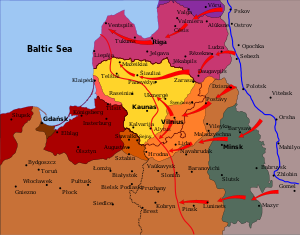Lithuanian Soviet Socialist Republic (1918–1919)
Lithuanian Soviet Socialist Republic
| |||||||||
|---|---|---|---|---|---|---|---|---|---|
| 1918–1919 | |||||||||
Yiddish[1] | |||||||||
| Government | Socialist republic | ||||||||
| Chairman | |||||||||
| Legislature | Provisional revolutionary government (Lithuania) | ||||||||
| Historical era | World War I | ||||||||
• Provisional revolutionary government formed | 8 December 1918 | ||||||||
• Republic established | 16 December 1918 | ||||||||
• Recognised by Soviet Russia | 22 December 1918 | ||||||||
• Capture of Vilnius | 5 January 1919 | ||||||||
• Merged with SSR Byelorussia | 27 February 1919 | ||||||||
| |||||||||
The Lithuanian Soviet Socialist Republic (LSSR) was a short-lived
Background
Germany had lost
Formation

In Lithuania, the communists were not active until late summer 1918. The
The government issued a manifesto, printed with a 16 December date, declaring the establishment of the Lithuanian Soviet Socialist Republic.
The newly formed LSSR asked for assistance from the
Similar republics were established in Latvia (the Latvian Socialist Soviet Republic) and Estonia (the Commune of the Working People of Estonia).
Government
The LSSR was new, weak and had to rely on Russian assistance.
The Soviets demanded large war contributions from captured cities and villages. For example, Panevėžys was required to pay 1 million rubles, Utena 200,000 rubles, while 10 rubles were demanded from villages.[13] They nationalized commercial institutions and large estates, assigning land for use in collective farming rather than redistribution to smaller farms.[13] Economic difficulties and cash shortage was illustrated by a decree published in January 1919 prohibiting financial institutions to pay more than 250 rubles per week to any resident.[15] In a country of staunch Catholics and determined nationalists, the Soviet promotion of internationalism and atheism alienated the local population and contributed, ultimately, to the Soviets' eventual withdrawal.[1][13]
Members of the Council of People's Commissars
| Members of the Council of People's Commissars | ||
|---|---|---|
| Position | As of 6 January 1919[16] | As of 22 January 1919[16] |
| Commissar of foreign affairs | Vincas Mickevičius-Kapsukas (also chairman) | |
| Commissar of internal affairs | Zigmas Aleksa-Angarietis (also deputy chairman)
| |
| Commissar of food | Aleksandras Jakševičius | M. Slivkin |
| Commissar of labor | Semyon Dimanstein | |
| Commissar of finance | Kazimierz Cichowski | |
| Commissar of transport | Pranas Svotelis-Proletaras | Aleksandras Jakševičius |
| Commissar of agriculture | Yitzhak Weinstein-Branovski |
Vaclovas Bielskis |
| Commissar of education | Vaclovas Biržiška | |
| Commissar of communications | – | Pranas Svotelis-Proletaras |
| Commissar of military affairs | – | Rapolas Rasikas |
| Commissar of the people's economy | – | Yitzhak Weinstein-Branovski
|
| Commissar of trade and industry | – | Yitzhak Weinstein-Branovski
|
Dissolution and aftermath
Between 8 and 15 February 1919, Lithuanian and German volunteers stopped the Soviet advance and prevented them from taking

When the tide turned in the Polish–Soviet War, the Soviets captured Vilnius on 14 July 1920. They did not transfer the city to the Lithuanian administration, as agreed in the
See also
References
- ^ ISBN 0-312-22458-3.
- Universal Lithuanian Encyclopedia.
- ^ ISBN 0-912760-17-6.
- ISBN 90-04-13754-8.
- ISBN 0-06-097468-0.
- ^ LCCN 55020366.
- ^ ISBN 5-89957-012-1.
- ISSN 0038-5859.
- ISBN 9955-423-23-4.
- ISBN 9986-09-055-5.
- ISSN 0966-8136.
- ^ ISBN 5-430-01059-6.
- ^ ISBN 0-415-26731-5.
- ISBN 9955-423-23-4.
- ISSN 1392-0456.
- ^ ISBN 0-8371-7780-4.
- ISBN 0-520-02600-4.
- ISBN 978-1-933648-15-6.
- ^ ISBN 0-300-10586-X.
- ISBN 0-312-22458-3.
- S2CID 156378406.


